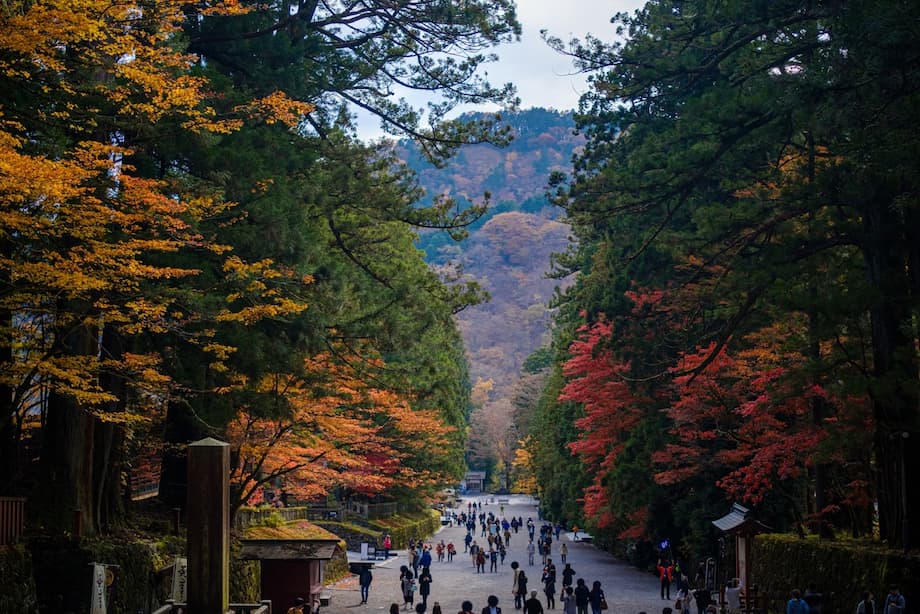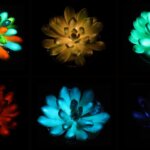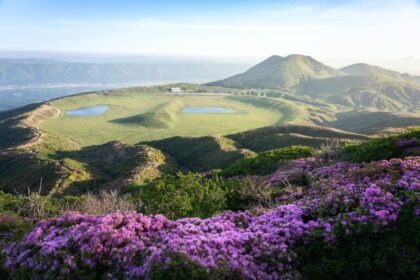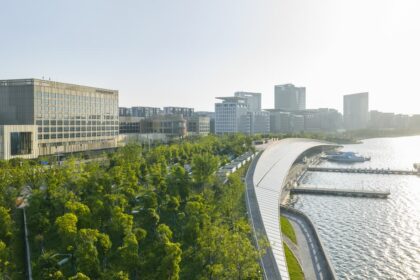Japan’s Early Autumn Magic: Where to See the First Fall Leaves
Japan’s autumn foliage, known locally as koyo or momiji, is one of the country’s most celebrated natural spectacles. While most travelers associate the vibrant reds and golds of Japanese maples with October and November, a select group of highland and northern destinations begin their transformation much earlier. For those visiting in early September, there’s no need to wait for the crowds or the peak season—Japan’s mountains and highlands offer a preview of autumn’s beauty, complete with crisp air, peaceful trails, and breathtaking vistas.
- Japan’s Early Autumn Magic: Where to See the First Fall Leaves
- Why Do Leaves Change Early in Some Parts of Japan?
- What Is Momijigari? The Tradition of Autumn Leaf Hunting
- 5 Early Autumn Leaf Viewing Spots in Japan
- Other Early Autumn Destinations: Hokkaido and Beyond
- How to Plan Your Early Autumn Leaf Viewing Trip
- What to Expect: Weather, Crowds, and Local Experiences
- Beyond the Leaves: Cultural and Spiritual Highlights
- Tips for Responsible and Enjoyable Leaf Viewing
- In Summary
This guide explores five of the best spots for early autumn leaf viewing in Japan, drawing from expert forecasts, local traditions, and firsthand travel experiences. Whether you’re a seasoned momijigari (autumn leaf hunter) or a first-time visitor, these destinations promise a unique and tranquil introduction to Japan’s fall colors.
Why Do Leaves Change Early in Some Parts of Japan?
Japan’s geography stretches over 3,000 kilometers from north to south, encompassing a wide range of climates and elevations. This diversity means that autumn arrives at different times across the country. The earliest colors appear in the far north (Hokkaido) and at high elevations, where cooler temperatures trigger the chemical changes that turn green leaves into fiery reds, oranges, and yellows.
According to japan-guide.com, the autumn color front begins in mid-September in Hokkaido’s mountains and gradually moves southward and downward in elevation, reaching Tokyo and Kyoto only in late November. In these early-phase locations, entire mountain slopes can turn brilliant shades weeks before the rest of the country.
What Is Momijigari? The Tradition of Autumn Leaf Hunting
The Japanese tradition of momijigari—literally “hunting red leaves”—dates back to the Heian period (794-1185). Aristocrats and poets would travel to scenic spots to admire the changing foliage, a practice that has since become a beloved national pastime. Today, both locals and tourists flock to famous parks, temples, and mountain trails to experience the fleeting beauty of autumn.
Unlike cherry blossom season, which lasts only about a week, autumn colors can be enjoyed for several weeks, making it easier to catch the spectacle. The activity is deeply woven into Japanese culture, inspiring seasonal foods, festivals, and even special nighttime illuminations at gardens and temples.
5 Early Autumn Leaf Viewing Spots in Japan
For those eager to experience Japan’s first blush of autumn, these five destinations offer the earliest and most spectacular displays of fall foliage. Each combines natural beauty with cultural or historical attractions, and most are accessible from major cities with a bit of planning.
1. Mt. Fuji’s 5th Station (Yamanashi Prefecture)
Rising to about 2,300 meters above sea level, Mt. Fuji’s 5th Station is not only a gateway for climbers but also one of the earliest places in Japan to witness autumn’s arrival. By the first week of September, the forested slopes begin to show flashes of gold and crimson, offering a dramatic contrast to the iconic volcano’s silhouette.
The cool mountain air provides a refreshing escape from the lingering summer heat of Tokyo, just 2.5 hours away by car or bus. Nearby, Lake Kawaguchi and Arakurayama Sengen Park offer panoramic views of Mt. Fuji framed by early autumn foliage—a photographer’s dream.
2. Karuizawa (Nagano Prefecture)
About 2.5 hours from Tokyo, Karuizawa is a stylish mountain resort town long favored by city dwellers seeking respite from the heat. Thanks to its elevation and abundant birch and maple trees, Karuizawa’s leaves begin to turn as early as late August in shaded areas, with more widespread color by early September.
Visitors can stroll down the charming Old Ginza shopping street, relax in chic cafés, or cycle through breezy forest roads. Shiraito Falls, a short drive away, offers a misty, photogenic setting surrounded by lush greenery and the first hints of gold. Karuizawa’s blend of natural beauty and modern comforts makes it an ideal early autumn escape.
3. Nikko (Tochigi Prefecture)
Nikko, a UNESCO World Heritage site about 2.5 hours from Tokyo, is renowned for its ornate shrines and dramatic mountain scenery. While the town center’s foliage peaks later in the season, higher-elevation areas like Lake Chuzenji and Senjogahara Marsh begin to change color in early September.
Early autumn visitors can enjoy cooler air and fewer crowds while exploring the intricately carved Toshogu Shrine or hiking to Ryuzu Falls, one of the first places in Nikko to display vibrant hues. The area’s combination of cultural heritage and natural splendor makes it a perennial favorite for autumn travelers.
4. Norikura Highlands (Nagano Prefecture)
Located over 1,500 meters above sea level, the Norikura Highlands are a hidden gem for early fall foliage seekers. About 3.5 hours from Nagoya or 4 hours from Tokyo, this region’s hiking trails, waterfalls, and scenic drives begin turning gold and crimson by early to mid-September.
Highlights include Zengoro Falls, the peaceful Echo Line drive, and relaxing soaks at local hot springs. The highlands’ remote location ensures a tranquil experience, far from the crowds that flock to more famous spots later in the season.
5. Togakushi Highlands (Nagano Prefecture)
About 3.5 hours from Tokyo, Togakushi is both a spiritual and scenic destination. The area is home to the Togakushi Shrine complex, famous for its ancient cedar avenue—a shaded, serene walk where hints of autumn color start to appear in early September.
Visitors can also enjoy handmade soba noodles, a regional specialty, and the peaceful Kagami-ike Pond, where the mirrored surface reflects the changing trees. Togakushi’s blend of natural beauty, spiritual history, and culinary delights makes it a rewarding early autumn destination.
Other Early Autumn Destinations: Hokkaido and Beyond
While the five spots above are easily accessible from Tokyo or Osaka, Japan’s northernmost island, Hokkaido, offers some of the country’s earliest and most dramatic autumn scenery. According to local experts, places like Daisetsuzan National Park and Ginsendai see their first colors as early as mid-September. The park’s vast mountains and valleys turn into a tapestry of red, orange, and yellow, attracting hikers and photographers from across Japan.
Other notable early autumn spots include:
- Oirase Stream and Lake Towada (Aomori): Pristine forests and crystal-clear waters, especially vibrant from late September to early October.
- Kamikochi (Nagano): A popular starting point for Japanese Alps hikes, with peak foliage in early to mid-October.
- Oze National Park (Gunma/Fukushima): Famous for its marshlands and fields of yellow autumn grass, best seen from late September to early October.
How to Plan Your Early Autumn Leaf Viewing Trip
Because early autumn destinations are often in remote or mountainous areas, planning ahead is essential. Here are some tips for a smooth and memorable trip:
- Check the latest foliage forecasts: The timing of autumn colors varies each year based on weather patterns. Websites like JRailPass and Nippon.com provide up-to-date predictions for each region.
- Consider private transfers or tours: Many early autumn spots have limited public transit, especially before the main season. Private transfers or guided tours can save time and offer flexibility for photo stops and scenic detours.
- Pack for variable weather: Early autumn in the mountains can be chilly, especially in the mornings and evenings. Layered clothing, waterproof jackets, and sturdy walking shoes are recommended.
- Book accommodations early: While crowds are smaller in early autumn, popular ryokan (traditional inns) and hotels near scenic spots can fill up quickly, especially on weekends.
What to Expect: Weather, Crowds, and Local Experiences
Early autumn in Japan offers several advantages for travelers:
- Cooler temperatures: Mountain and highland areas provide a refreshing break from the lingering heat and humidity of the cities.
- Fewer crowds: Visiting before the peak season means quieter trails, easier photo opportunities, and a more relaxed pace.
- Seasonal foods and festivals: Autumn is a time for culinary delights like roasted chestnuts, sweet potatoes, and matsutake mushrooms. Some regions host early autumn festivals or nighttime illuminations, adding to the festive atmosphere.
- Onsen (hot springs): Many early autumn destinations are famous for their hot springs, offering the perfect way to unwind after a day of leaf hunting.
Beyond the Leaves: Cultural and Spiritual Highlights
Autumn leaf viewing in Japan is about more than just scenery. Many of the best spots are tied to centuries-old temples, shrines, and spiritual traditions. For example, Nikko’s Toshogu Shrine is not only a masterpiece of architecture but also a place of deep historical significance. Togakushi’s ancient cedar avenue leads to shrines that have been pilgrimage sites for over a thousand years.
Participating in momijigari connects visitors to a living tradition, celebrated in poetry, art, and seasonal cuisine. Local specialties—like handmade soba in Togakushi or hotou noodle soup near Mt. Fuji—offer a taste of regional culture. Nighttime illuminations at gardens and temples, though more common in the peak season, sometimes begin in early autumn, creating a magical atmosphere.
Tips for Responsible and Enjoyable Leaf Viewing
- Respect nature: Stay on marked trails, avoid picking leaves, and carry out all trash.
- Be mindful of local customs: Many temples and shrines have specific rules for visitors. Dress modestly and observe posted guidelines.
- Support local businesses: Enjoy meals at family-run restaurants, purchase local crafts, and consider staying at traditional inns to help sustain rural communities.
In Summary
- Japan’s earliest autumn colors appear in highland and northern regions, starting as early as late August and early September.
- Top early autumn destinations include Mt. Fuji’s 5th Station, Karuizawa, Nikko, Norikura Highlands, and Togakushi Highlands.
- Hokkaido’s Daisetsuzan National Park and other northern spots offer dramatic early foliage for adventurous travelers.
- Planning ahead is essential due to limited transit and variable weather in remote areas.
- Early autumn leaf viewing offers cooler temperatures, fewer crowds, and unique cultural experiences, including onsen and seasonal foods.
- Participating in momijigari connects visitors to a centuries-old Japanese tradition of celebrating nature’s fleeting beauty.












